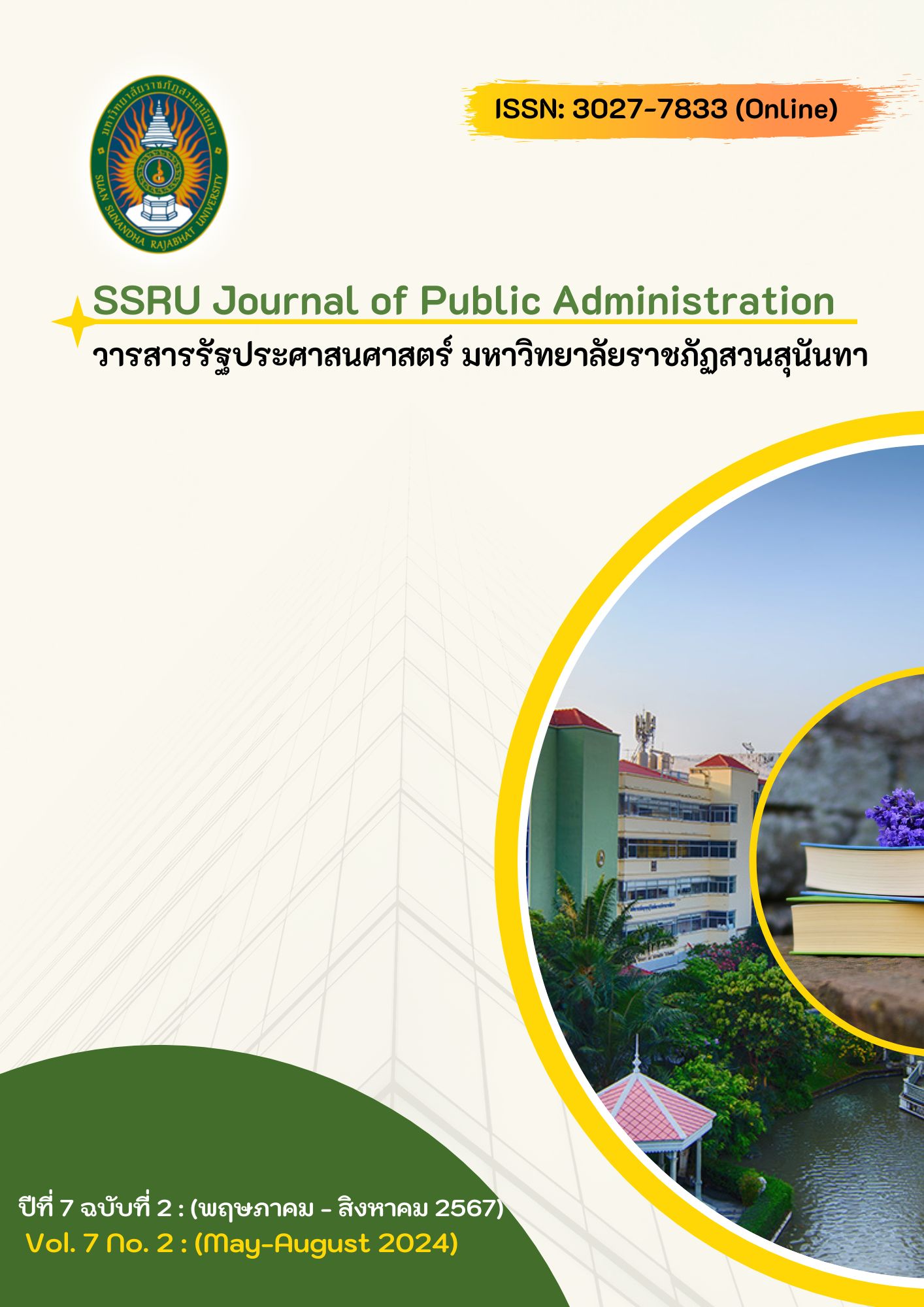แบบจำลองการเสริมสร้างความภักดีของลูกค้าคลินิกเสริมความงาม ในเขตกรุงเทพมหานครและปริมณฑล
Main Article Content
บทคัดย่อ
การวิจัยครั้งนี้มีวัตถุประสงค์เพื่อ 1) ศึกษาระดับความมีชื่อเสียงของแพทย์ผู้ทำศัลยกรรม คุณภาพการบริการ นวัตกรรม เทคโนโลยี คุณค่าการรับรู้ ความตั้งใจในการเสริมความงาม และความภักดีของลูกค้าคลินิกเสริมความงามในเขตกรุงเทพมหานครและปริมณฑล 2) ศึกษาอิทธิพลของความมีชื่อเสียงของแพทย์ผู้ทำศัลยกรรม คุณภาพการบริการ นวัตกรรม เทคโนโลยี คุณค่าการรับรู้ และความตั้งใจในการเสริมความงาม ที่ส่งผลต่อ ความภักดีของลูกค้าคลินิกเสริมความงามในเขตกรุงเทพมหานครและปริมณฑล 3) พัฒนาแบบจำลองความภักดีของลูกค้าคลินิกเสริมความงามในเขตกรุงเทพมหานครและปริมณฑล การวิจัยนี้ใช้การวิจัยแบบผสานวิธี การวิจัยเชิงปริมาณ กลุ่มตัวอย่างคือ ลูกค้าคลินิกเสริมความงามในเขตกรุงเทพมหานครและปริมณฑลจำนวน 360 คน ใช้วิธีการสุ่มกลุ่มตัวอย่างแบบมีสัดส่วน ใช้แบบสอบถามในการเก็บข้อมูล วิเคราะห์ข้อมูลด้วยแบบจำลองสมการโครงสร้าง ส่วนการวิจัยเชิงคุณภาพใช้วิธีการสัมภาษณ์แบบเจาะลึก กลุ่มผู้ให้ข้อมูลหลักคือ ลูกค้าคลินิกเสริมความงามในเขตกรุงเทพมหานครและปริมณฑล และผู้เชี่ยวชาญด้านการเสริมสร้างความภักดีของลูกค้าคลินิกเสริมความงามในเขตกรุงเทพมหานครและปริมณฑล
ผลการวิจัยพบว่า 1) ความมีชื่อเสียงของแพทย์ผู้ทำศัลยกรรม คุณภาพการบริการ นวัตกรรม เทคโนโลยี คุณค่าการรับรู้ ความตั้งใจในการเสริมความงาม และความภักดีของลูกค้าคลินิกเสริมความงามในเขตกรุงเทพมหานครและปริมณฑล อยู่ในระดับปานกลาง 2) ความมีชื่อเสียงของแพทย์ผู้ทำศัลยกรรม คุณภาพการบริการ นวัตกรรม เทคโนโลยี คุณค่าการรับรู้ และความตั้งใจในการเสริมความงาม มีอิทธิพลต่อความภักดีของลูกค้าคลินิกเสริมความงามในเขตกรุงเทพมหานครและปริมณฑล อย่างมีนัยสำคัญทางสถิติ และ 3) แบบจำลองความภักดีของลูกค้าคลินิกเสริมความงามในเขตกรุงเทพมหานครและปริมณฑล ที่ผู้วิจัยพัฒนาขึ้นมีชื่อว่า TPIQVC Model (T= Technology, P= Prominence Plastic Surgeon, I= Innovation, Q= Quality Service, V= Perceived Value, C= commitment beauty)
Article Details

อนุญาตภายใต้เงื่อนไข Creative Commons Attribution-NonCommercial 4.0 International License.
เอกสารอ้างอิง
ทิวานันท์ โตนุ่น. (2560). พฤติกรรมการใช้บริการสถาบันเสริมความงามด้านศัลยกรรม (วิทยานิพนธ์บริหารธุรกิจมหาบัณฑิต). มหาวิทาลัยศิลปากร.
Diamantopoulos, A., Siguaw, J. A., & Cadogan, J. W. (2000). Export performance: The impact of cross-country export market orientation. In American Marketing Association. Conference Proceedings (p.177). Chicago: American Marketing Association.
Hair, J. F., et al. (2011). PLS-SEM: Indeed a Silver Bullet. Journal of Marketing Theory and Practice, 19, 139-151.
International Society of Aesthetic Plastic Surgery. (2020). ISAPS International Survey on Aesthetic/Cosmetic Procedures performed in 2020. Retrieved June 20, 2023, from https://www.isaps.org/wp-content/uploads/2022/01/ISAPS-Global-Survey_2020.pdf
Jain, V. & Ajmera, P. (2018). Modelling the factors affecting Indian medical tourism sector using interpretive structural modeling. Benchmarking: An International Journal, 25(5), 1461-1479.
Kazi, A., et al. (2019). Sedentary behavior and health at work: an investigation of industrial sector, job role, gender and geographical differences. Ergonomics, 62(1), 21-30.
Khan, S. A. R., et al. (2020). Investigating the effects of renewable energy on international trade and environmental quality. Journal of Environmental management, 272, 111089.
Kucukusta, D., Hudson, S. & DeMicco, F. J. (2019). Medical tourism: strategies for quality patient/guest experiences. Journal of Hospitality and Tourism Insights, 2(3), 221-223.
Likert, R. (1932). A technique for measurement of attitudes. Archives of Psychology, 140, 5-55.
Liu, C. H., et al. (2020). Factors associated with depression, anxiety, and PTSD symptomatology during the COVID-19 pandemic: Clinical implications for US young adult mental health. Psychiatry research, 290, 113172.
Meera, S. & Vinodan, A. (2019). Attitude towards alternative medicinal practices in wellness tourism market. Journal of Hospitality and Tourism Insights, 2(3), 278-295.
Nguyen, T. L. H. & Nagase, K. (2018). Patient satisfaction and loyalty to the healthcare organization. International Journal of Pharmaceutical and Healthcare Marketing, 15(4), 496-515.
Pan, S.L. & Zhang, S. (2020). From fighting COVID-19 pandemic to tackling sustainable development goals: An opportunity for responsible information systems research. International journal of information management, 55, 102196.
Pevec, T., & Pisnik, A. (2018). Empirical evaluation of a conceptual model for the perceived value of health services. Slovenian Journal of Public Health, 57(4), 175-182.
Rehaman, B. & Husnain, M. (2019). The impact of service quality dimensions on patient satisfaction in the private healthcare industry in Pakistan. Journal of Hospital and Medical Management, 4(1), 1-9.
Royo-Vela, M., Amezquita Salazar, J. C. & Puig Blanco, F. (2022). Market orientation in service clusters and its effect on the marketing performance of SMEs. European Journal of Management and Business Economics, 31(1), 1-21.


